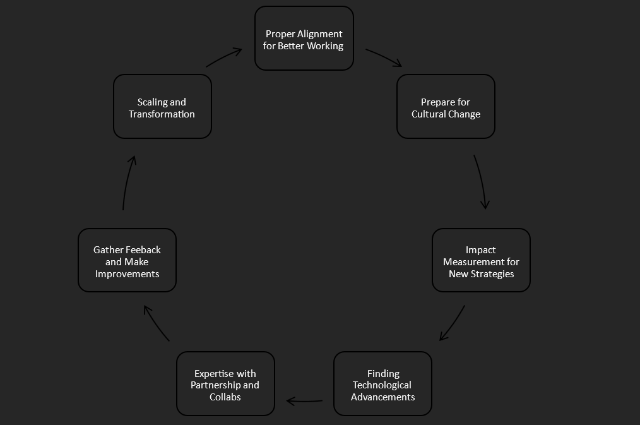
Image by StartupStockPhotos from Pixabay
DIGITAL TRANSFORMATION - SCALING PRODUCTIVITY WITH THE HELP OF TECHNOLOGY
In the era of changing technology, there is a need for a modern methodology for making manual work automated to achieve better outcomes with an increase in efficiency and productivity. For fulfilling such requirements there is a need for digital transformation in the online world for performing day-to-day activities easily with higher productivity.
"Embrace change, drive innovation."
The Need for Acceleration of digital transformation is due to the evolution of technologies and the increase in the availability needs of data and its usage. Real-time data plays a major role in digital transformation by keeping the important data about consumers, the market, supply chain, and competitors to help analyse and improve according to the consumer needs for better outcomes.
The Benefits of digital transformation include:
It can be applied across various fields and sectors. (Tool & Description)
- Healthcare: Enhances patient care through telemedicine and electronic health records.
- Finance: Improves transaction speed and security with digital banking and blockchain.
- Education: Expands access to learning with online courses and virtual classrooms.
- Retail: Personalizes shopping experiences with data analytics and AI-driven recommendations.
- Manufacturing: Increases efficiency with automation and predictive maintenance.
- Transportation: Optimizes routes and reduces costs with real-time tracking and logistics management.
- Agriculture: Boosts crop yields with precision farming and IoT sensors.
- Public Sector: Streamlines services and enhances citizen engagement through e-governance.
- Human Resources: Streamlines services and enhances citizen engagement through e-governance.
- It facilitates technology sharing and technology upgrades.
- It drives innovation and revolutionizes business strategies.
- Helps in understanding and meeting consumer needs.
- Expands the shopping experience, as seen with e-commerce websites like Flipkart and Amazon, leading to increased business turnovers.
- Aids businesses in making the right decisions, boosting success rates through innovation.
- Improves customer experience through real-time data tracking and feedback.
- Enables easy transformation and enhancement of business strategies.
The Tools of digitalization:
"Unlock potential with digital tools."
Digital transformation is dependent on the data, so proper collection, security, analysis of the data, and application of data are required to complete the whole process. (Tool & Description)
- Cloud Computing: Provides scalable storage and computing power on demand.
- Artificial Intelligence (AI): Automates tasks and offers predictive analytics.
- Internet of Things (IoT): Connects devices for real-time data collection and monitoring.
- Big Data Analytics: Analyzes large datasets to uncover insights and trends.
- Robotic Process Automation (RPA): Automates repetitive and mundane tasks.
- Blockchain: Ensures secure and transparent transactions.
- 5G Technology: Enhances connectivity and supports real-time communication.
- AR/VR: Creates immersive experiences for training, education, and entertainment.
FRAMEWORK OF DIGITAL TRANSFORMATION STRATEGIES

Figure - Framework of Digital transformation strategies for increasing success and productivity in an organization
- Proper Alignment for Better Working: Ensure that all departments and teams are aligned with the digital transformation goals for cohesive operation.
- Prepare for Cultural Change: Foster a culture that embraces change, innovation, and continuous learning to support transformation efforts.
- Impact Measurement for New Strategies: Regularly assess the effectiveness of new strategies and technologies to ensure they meet desired outcomes.
- Finding Technological Advancements: Stay updated with the latest technological developments to continuously improve and innovate processes.
- Expertise with Partnership and Collabs: Leverage external expertise and form strategic partnerships to enhance capabilities and drive transformation.
- Gather Feedback and Make Improvements: Collect feedback from stakeholders and use it to make iterative improvements to digital initiatives.
- Scaling and Transformation: Scale successful digital initiatives across the organization to maximize their impact and drive widespread transformation.
DIGITAL TRANSFORMATION IN AN ORGANIZATION
For overall growth and an increase in the success rate of an organization digital transformation plays a major role.
With the Traditional and Manual Methodology, it’s very difficult to compete with conditions in current market scenarios. For building new building model and generating new opportunities digitalization play an important part in offering faster and improved services to consumers.
"Adapt, innovate, and succeed."
With the help of digitalization:
An organization generates more profit and success rate when compared to traditional methodologies.
Customers:
- Through digital transformation, engaging customers towards products and services have become easy with the help of futuristic technologies like artificial intelligence for automation purpose and machine learning for improving the services through feedback.
- Digitalization helps to provide an overall view of the customer's needs and know their usage.
Employees:
- The digital solution helps to empower employees to develop new skills and improve current skills while optimizing overall operations.
- It also helps accommodating employees in different work styles
- Modern capabilities helps in increasing digital literacy and delivering their best work anywhere.
- This even helps protect the important data of an organization.
The research and development domains play a major role in designing futuristic products and services for disrupting established markets. The entire infrastructure and innovation of an organization work in a structured and pre-planned manner with the help of digital transformation, which also targets to fulfill the future needs of an organization. With the help of digital transformation now flexibility and integrity of an organization can be easily maintained and provide a success rate.
CONCLUSION
In conclusion, embracing digital transformation is imperative for organizations to thrive in the modern era of rapid technological evolution. By adopting a digital-first approach, companies can automate manual tasks, enhance productivity, and streamline day-to-day operations. customer experiences, and driving business growth.
"Transform today for a better tomorrow."
A robust framework for digital transformation includes aligning teams with strategic goals, preparing for cultural change, measuring the impact of new strategies, staying updated with technological advancements, leveraging partnerships, gathering feedback, and scaling successful initiatives.
Thus, digital transformation is not just a technological shift but a comprehensive strategy for sustainable development and competitive advantage.
